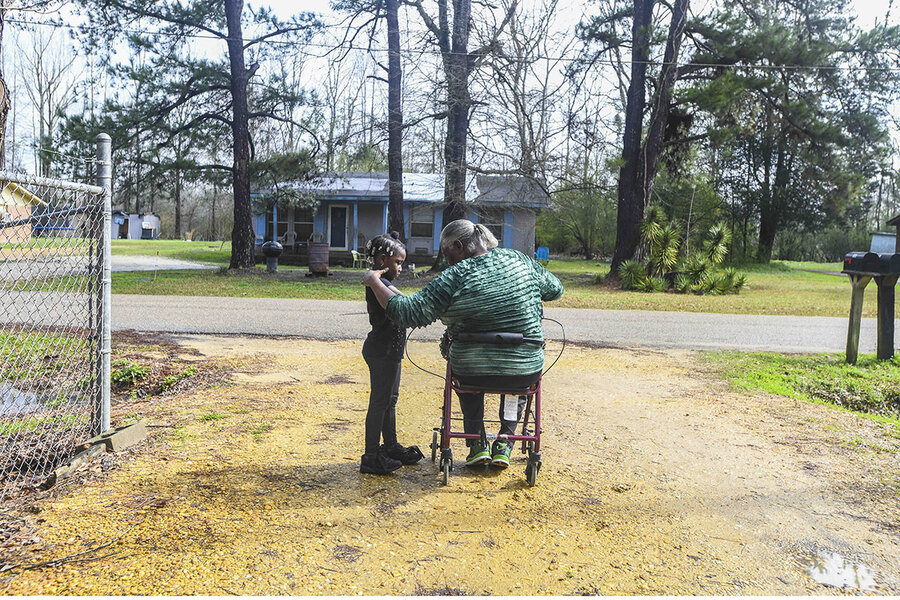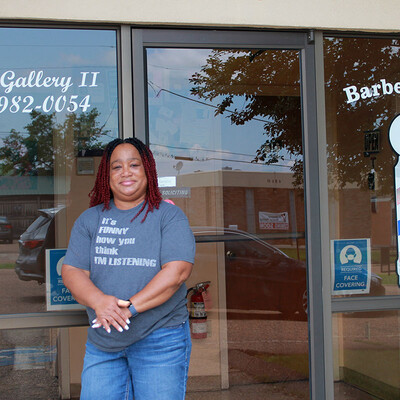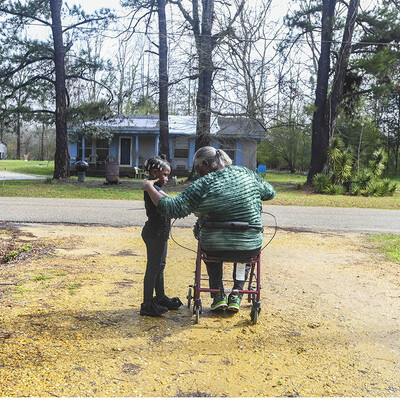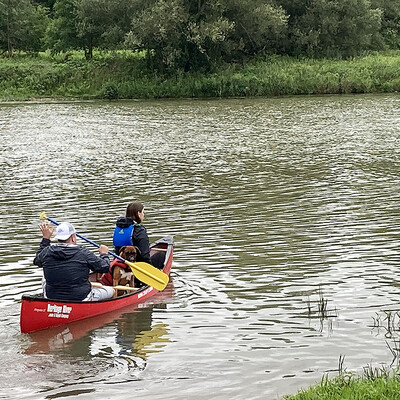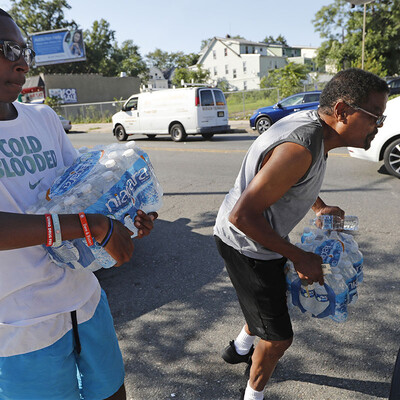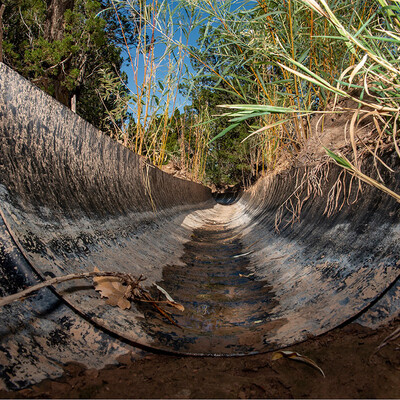Sewage equity? In Alabama, trust is as important as pipes.
Loading...
| Lowndes County, Ala.
Until 1972, the United States had no national standard for wastewater treatment. Then came the Clean Water Act, which allocated more than $60 billion to upgrade the nation’s infrastructure. But in 1990, federal grants were replaced by low-interest loans, leaving rural and low-income areas struggling. A septic system can cost more than a house in a place like Lowndes County, Alabama.
Many there have no access to sewage treatment. Sewage runs directly into the yard, creating both environmental and health hazards.
Why We Wrote This
Wastewater infrastructure in the U.S. tells a story of haves and have-nots. But a partnership in rural Alabama may have found a scalable way to narrow that gap. Second in a series on water and justice.
But the new Lowndes County Unincorporated Wastewater Project – a nonprofit partnership among locals, businesses, the state Department of Environmental Services, and the federal government – is working to change that. Nearly 200 houses in Lowndes County are set to receive a septic system this summer.
Perman Hardy was among the first to get one. Now, she doesn’t have to stop using the sink, shower, toilet, or washing machine when it rains to avoid having wastewater back up into her home. A vocal advocate in the community, she encourages others to set aside their distrust of state officials and embrace a healthier approach to wastewater management.
“It already has changed my life,” says Ms. Hardy. “The plumbing system has changed my life.”
For almost 30 years Perman Hardy obeyed a simple rule: When it rains, turn off the water.
Ms. Hardy had a failing septic system, and precipitation meant wastewater flowing from her house wouldn’t be treated and released into the soil. More likely, it would flow back into her home. So until the last raindrop fell, she halted everything involving a sink, shower, toilet, or washing machine.
Still, Ms. Hardy considers herself fortunate. For one, in her hometown in Lowndes County, Alabama – one of the state’s poorest and most rural – many people don’t have access to sewage treatment at all. For another, as of this summer, Ms. Hardy no longer has to follow her rule.
Why We Wrote This
Wastewater infrastructure in the U.S. tells a story of haves and have-nots. But a partnership in rural Alabama may have found a scalable way to narrow that gap. Second in a series on water and justice.
Ms. Hardy’s is among the first of around 175 homes slated to receive septic systems through the Lowndes County Unincorporated Wastewater Project, which officially launched in late June. More than three years in the making, the LCUWP is a nonprofit partnership among locals, businesses, the state Department of Environmental Services, and the federal government. Residents apply and, if accepted, contribute a down payment and then $20 per month as incentive to maintain the system. The program covers the rest.
At once, the LCUWP displays how beneficial community projects can be, and, on the national scale, how intractable the issue of wastewater is. Even in Lowndes, with a population of less than 10,000, the issue is too big for any one program to solve. Around 80% of people in Alabama’s Black Belt, a slice of heavily African American counties that once included many of the state’s enslaved people, lack adequate wastewater treatment. Nationwide, more than 2 million other Americans don’t have access to running water or indoor plumbing, and even more go without wastewater treatment. Limited infrastructure is most pronounced in rural and tribal communities, from the Deep South to Alaska.
As Washington debates infrastructure spending, people who live in those areas are left to look for solutions in the interim. Those involved in the LCUWP hope that their program might become a model for other counties in Alabama and nationwide. Helping pockets of underserved communities won’t end the country’s wastewater crisis, but it might put a dent in it. For those who benefit, a dent doesn’t feel so small.
“It already has changed my life,” says Ms. Hardy. “The plumbing system has changed my life. The septic system has changed my life.”
From grants to loans: Financing sanitation
Until 1972 there was no national standard for wastewater treatment, and few federal funds allocated to improve it. Then came the Clean Water Act, requiring at least secondary treatment for all wastewater systems nationwide.
Under secondary treatment, solids separate from liquids and the remaining wastewater is purified with a biological process. To upgrade the nation’s infrastructure, the Clean Water Act allocated more than $60 billion, the largest public works investment in American history, says Adam Krantz, CEO of the National Association of Clean Water Agencies.
But grants alone weren’t enough. Maintaining wastewater infrastructure is expensive, and many localities neglected that step after taking federal money for construction. In an effort to boost accountability, Congress ended the grants in 1990 and replaced it with a system of low-interest loans available for local governments to upgrade their infrastructure. For rural and low-income areas, this immediately created financing issues and left a path to today’s infrastructure environment of haves and have-nots.
“It should not surprise any of us … that there are still communities in the United States – many communities particularly in rural areas – that do not have sewage treatment,” says Alexandra Dapolito Dunn, a partner at the law firm Baker Botts and an expert on wastewater infrastructure.
Because households are spread so far apart in rural areas, connecting them on a shared sewer system isn’t practical. Septic tanks or other local treatment systems are necessary but also expensive, often costing upward of $10,000. In areas like Lowndes, the system sometimes costs more than the house.
As a result, many homes in Lowndes lack any sanitation treatment at all. Households often run their wastewater directly into the yard, with what are known as straight pipes. This harms not only the environment but also residents’ health – incubating bacteria, damaging homes, breeding mosquitoes, and discouraging people from drinking water or using it to shower.
“The people that tend to be impacted by this most are either poor people or people of color,” says Catherine Coleman Flowers, a former Lowndes resident and founder of the Center for Rural Enterprise and Environmental Justice, which works to improve access to clean air, water, and sanitation in marginalized rural communities.
Building trust along with infrastructure
Solving America’s wastewater problem, though, is like solving its housing crisis, says Ms. Dunn. There’s no simple, short-term answer.
If passed into law, Congress and the White House’s bipartisan infrastructure deal would become the nation’s largest investment in clean drinking water and wastewater infrastructure. The Treasury Department is also allowing states to spend the state and local funds allocated in the American Rescue Plan to help remedy the problem.
Yet, while funding is a big obstacle – local governments are responsible for 90% of wastewater funding, says Ms. Dunn – it’s not the only one. In a heavily Black and historically segregated area like Lowndes, education rates are low and trust deficits run wide.
Many in the area have spent their whole lives without proper wastewater treatment and don’t know why it’s a problem, or how to maintain a new system. Residents sometimes assume state officials are out to punish them and won’t open their doors.
Sherry Bradley, LCUWP’s program originator and deputy director of the Bureau of Environmental Services at the Alabama Department of Public Health, spent years driving from her office in Montgomery into Lowndes to form relationships in the county. While onerous, those trips helped her earn the trust of people like Ms. Hardy, who has since become a vocal advocate in the community and chair of LCUWP’s board.
The daughter of a sharecropper, Ms. Hardy picked cotton on a local farm as a child and knows the legacy of poverty and segregation in Lowndes. Like many in the county, she shares property with her extended family, who live in separate houses next to crops and horses.
“I built that trust growing up all my life here,” says Ms. Hardy.
The aim, she says, is for the next generation to have better access and understanding than she had. The LCUWP isn’t the whole solution, but it’s been empowering for the community to see nearly 200 households that are set to benefit. The goal of improving wastewater has taken on so many forms over so many years that broken ground, excavators, and giant septic tanks have become a beautiful and even empowering sight.
Lowndes County is the center of America’s wastewater problem, says Ms. Bradley, who is traveling to Alaska later this year to share information about LCUWP’s program. But maybe, she says, it holds part of the solution.
“This is an example,” she tells the counties around her. “You can do the same thing.”
Read the first article in our water and justice series.




